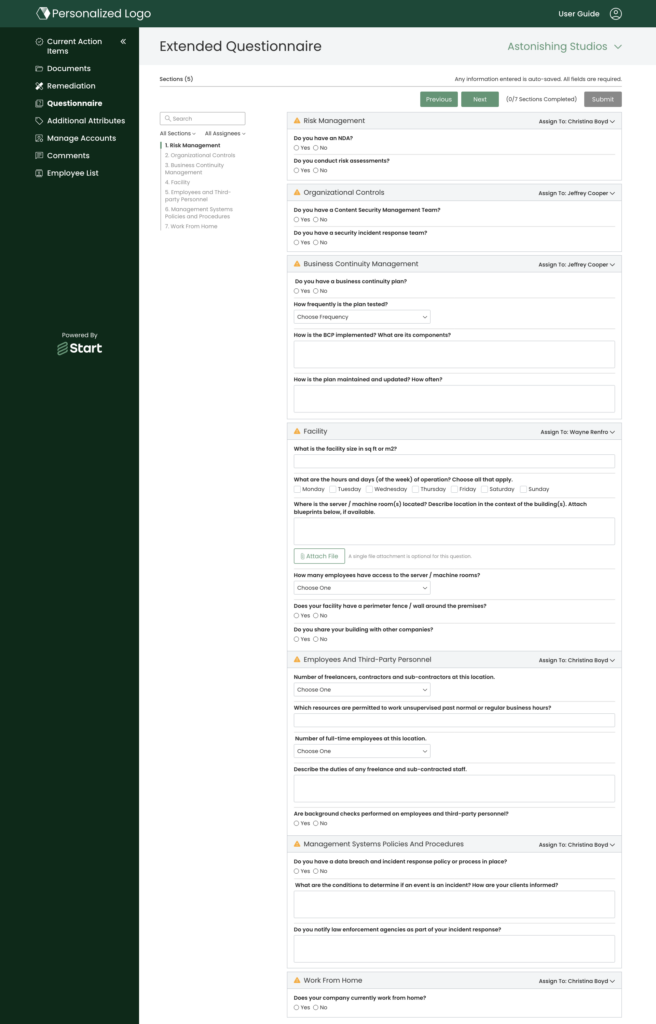Are you still using a singular vendor assessment questionnaire to qualify all your vendors? Security teams know that a singular questionnaire template won’t fit every vendor. However, a lot of organizations are using a one-questionnaire-fits-all approach. A well-designed vendor assessment questionnaire helps gather essential information about potential vendors, enabling you to decide whom to partner with. When you use a questionnaire without nuance depending on the vendor, problems arise and your risk increases.
One Vendor Assessment Questionnaire Does Not Fit All
One questionnaire to rule them all is poor practice when performing vendor assessments. When you use a single questionnaire for various vendor types and industries, there will always be questions that don’t apply to specific vendors. In our experience, this causes friction on the vendor’s part and issues for the assessors.
Vendor Frustration
Vendor assessment questionnaires typically have between one hundred and three hundred questions. If you present a vendor with a lengthy, technical questionnaire and some questions don’t apply to them, they will become frustrated by how often they have to write N/A as their answer. For example, if you assess a VFX company, asking them about physical products doesn’t make sense. This frustration can translate into an unwillingness to be engaged in audits and can also extend assessment time or lose the partnership.
Assessor Issues
On the assessor side, making a vendor questionnaire longer than necessary by including irrelevant questions means that this adds to the assessor’s workload. The more questions an assessor has to review, the longer the process takes; if the answer is “not applicable” repeatedly, this wastes the assessors’ time. Often, a single assessor works on assessments for multiple vendors, and the time spent on inessential questions leads to an inefficient use of time, drawing out the process.
To assist in your research creating assessment questionnaires, check out this YouTube video on How to Improve Your Vendor Risk Questionnaires.
Tips For a Customizing Vendor Questionnaire
The more efficient you make your questionnaires, the more approachable they will seem to vendors. Here are our tips for customizing vendor questionnaires so they appear manageable to vendors and are more efficient for assessors.
Focus on Essential Criteria
Keep questionnaires as concise and focused as possible. The more efficient the questionnaire is, the more approachable it will seem to vendors. As noted above, you don’t want to overwhelm vendors with too many questions. Stick to questions directly relevant to your security requirements, decision-making process, and the vendor’s service area.
Keep Language Clear and Simple
Use straightforward language to avoid confusion and misinterpretation. Avoid terms that may not be familiar to the vendors you are assessing. If your questions cause vendors to ask for clarification, they need to be updated.
Use Conditional Questions
To prevent questionnaires from appearing daunting at first glance, make use of conditional questions. You can nest questions that only appear depending on the answers to other questions. For example, if the answer is Yes, show the conditional question; if it’s No, the vendor can move on or vice versa. Conditionality can also reduce redundancy in the questions presented and the time vendors take to complete the questionnaire.
Customizing Your Vendor Assessment Questionnaire with Start
So now you may be asking, “Do I have to create a custom questionnaire for every vendor manually?” Not with Start.
Start uses a mapping framework to apply tags to questions. Similar to how it handles tailored control tags, questions can link to the various service areas your vendors work in. When Start automatically generates the vendor’s questionnaire, it only pulls in the questions that match their service tags, resulting in a dynamically generated, vendor-specific questionnaire. Vendors will only see questions relevant to them.

The automated questionnaire-building process helps streamline the audit and reduces unnecessary questions. This leads to timelier responses and a better experience for the vendor. It also means that assessors don’t have to spend time manually customizing vendor questionnaires and can narrow in on the information that matters more quickly. Chat with one of our experts today to learn more about how Start uses tagging to create customized questionnaires.



